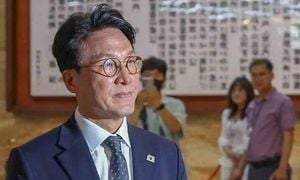South Korea's export landscape took a hit in May 2025, breaking a three-month winning streak as shipments to two of its largest markets, the United States and China, declined amid ongoing trade tensions and sweeping tariffs imposed by the Trump administration. Government data released on Sunday revealed that outbound shipments fell 1.3% year-on-year to $57.27 billion, marking the first drop since January and signaling the tangible impact of US tariff policies on the global economy and South Korea's trade performance.
Industry Minister Ahn Duk-geun highlighted the significance of the decline, stating, "The US tariffs seem to be affecting the global economy and South Korea's exports, proven by a decrease in South Korea's exports to the two biggest markets -- the US and China." This downturn reflects the broader challenges facing South Korea's export-driven economy, which relies heavily on robust trade relationships with these key partners.
The Ministry of Trade, Industry and Energy's detailed report showed that imports also dipped by 5.3% to $50.33 billion, resulting in a trade surplus of $6.94 billion for the fourth consecutive month. While the overall export figures declined, the report offered a nuanced view of sectoral performances across the country's 15 major export categories.
Semiconductors emerged as a bright spot, with exports soaring 21.2% year-on-year to a record $13.79 billion in May. This growth was driven by strong demand for high-end memory products, including double data rate 5 (DDR5) and high bandwidth memory (HBM) chips, which are critical components in generative artificial intelligence (AI) chipsets. Mobile device shipments also increased by 3.9% to $1.30 billion, fueled by robust smartphone demand, while computer exports rose 2.3% to $1.07 billion, supported by solid sales of solid state drives (SSD) for servers.
However, the automotive sector, a cornerstone of South Korea's export economy, faced significant headwinds. Automobile exports fell 4.4% to $6.20 billion, and auto parts shipments dropped 9.4% to $1.66 billion. The ministry attributed this decline largely to the 25% tariffs imposed by the United States on imported cars and auto parts. Additionally, Hyundai Motor Group's strategic move to operate a manufacturing plant in Georgia, USA, aimed at mitigating tariff impacts, also influenced the reduced outbound shipments.
Other sectors experienced mixed results: ship exports rose 4.3% to $2.23 billion, but general machinery exports declined 5.3% to $4.06 billion. Oil product exports plunged 20.9% to $3.58 billion amid lower global prices for gasoline and diesel, which fell 17.7% and 18.4% respectively year-on-year. Petrochemical shipments also dropped 20.8% to $3.24 billion, affected by a global supply glut and cheaper crude oil. Steel product exports shrank 12.4% to $2.56 billion, while secondary battery shipments slipped 18.4% to $520 million. Home appliances and textiles faced double-digit declines, falling to $610 million and $850 million respectively.
Regionally, exports to the United States contracted by 8.1% to $10.05 billion, marking the second consecutive month of decline, largely driven by weak demand in the automotive sector. Shipments to China also fell 8.4% to $10.4 billion, impacted by reduced semiconductor and petroleum product exports. The drop in petroleum-related exports was compounded by a decline in global oil prices to approximately $60 per barrel in May. Exports to the Association of Southeast Asian Nations (ASEAN) decreased 1.3% to $10.01 billion, affected by weaker demand for oil products and petrochemicals.
In contrast, exports to the European Union bucked the downward trend, rising 4.0% to $6.05 billion, buoyed by strong demand for automobiles and semiconductors. Exports to other regions such as Japan, Latin America, India, and the Middle East also declined, standing at $2.38 billion, $2.21 billion, $1.62 billion, and $1.38 billion respectively.
Amid these challenges, the South Korean government is taking proactive steps to support exporters. Minister Ahn emphasized the government's commitment to mitigating the impact of US tariffs, stating, "To minimize the damage to our export companies and maximize national interest, the government will clearly communicate our position on US tariff measures to the Trump administration and work toward mutually beneficial solutions." He further detailed swift implementation plans for a supplementary budget, including 150 billion won ($108.4 million) allocated for tariff-related trade insurance aimed at small- and mid-sized firms, and 84.7 billion won for tariff response vouchers.
The backdrop to these developments is the ongoing trade war initiated by former President Donald Trump, who has imposed a series of sweeping tariffs on major trading partners, including South Korea. Recently, Trump announced a 90-day pause on the implementation of his so-called "Liberation Day" tariff, offering temporary relief and a chance for negotiations. However, at a rally in Pennsylvania on May 30, 2025, he declared plans to double tariffs on steel imports from 25% to 50%, asserting that this move "will even further secure" the US steel industry.
The impact of these tariffs has been felt keenly in South Korea's automotive sector, where the 25% tariff on US-bound cars and auto parts has dampened exports. Nevertheless, the rise in electric vehicle exports to Europe and a surge in used car shipments have helped keep total automobile exports above the $6 billion mark, offering a glimmer of resilience.
While the trade tensions continue to cast a shadow over South Korea's export performance, the country's semiconductor industry remains a robust pillar, benefiting from the global surge in demand for advanced memory chips essential for AI technologies. This sector's strength underscores South Korea's strategic position in the global technology supply chain, even as other areas face tariff-induced headwinds.
Looking ahead, the South Korean government aims to navigate these turbulent trade waters through diplomatic engagement and targeted support for affected industries. The balance between protecting national economic interests and maintaining strong trade relationships will be critical as global trade dynamics evolve in the face of protectionist policies.




